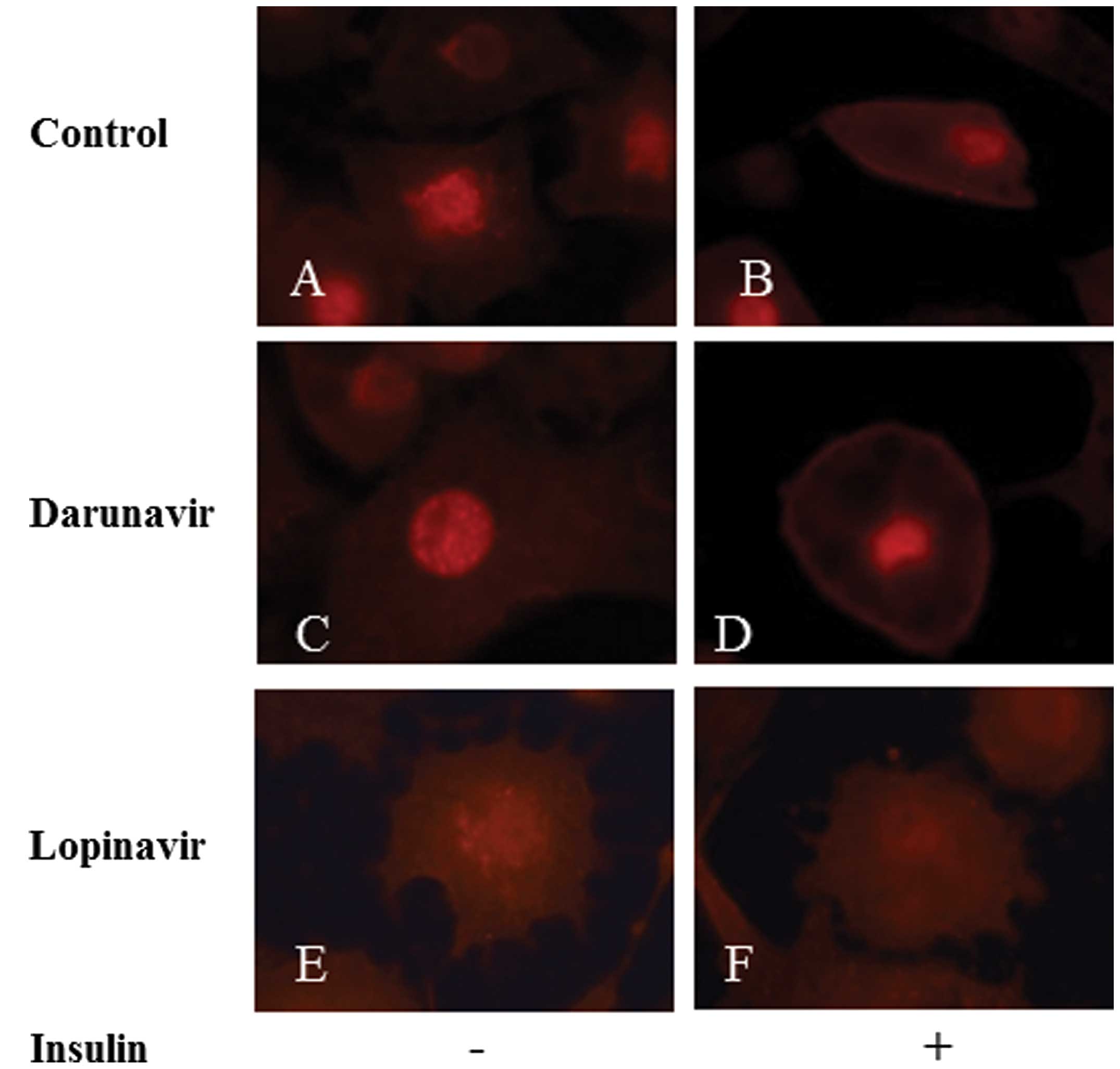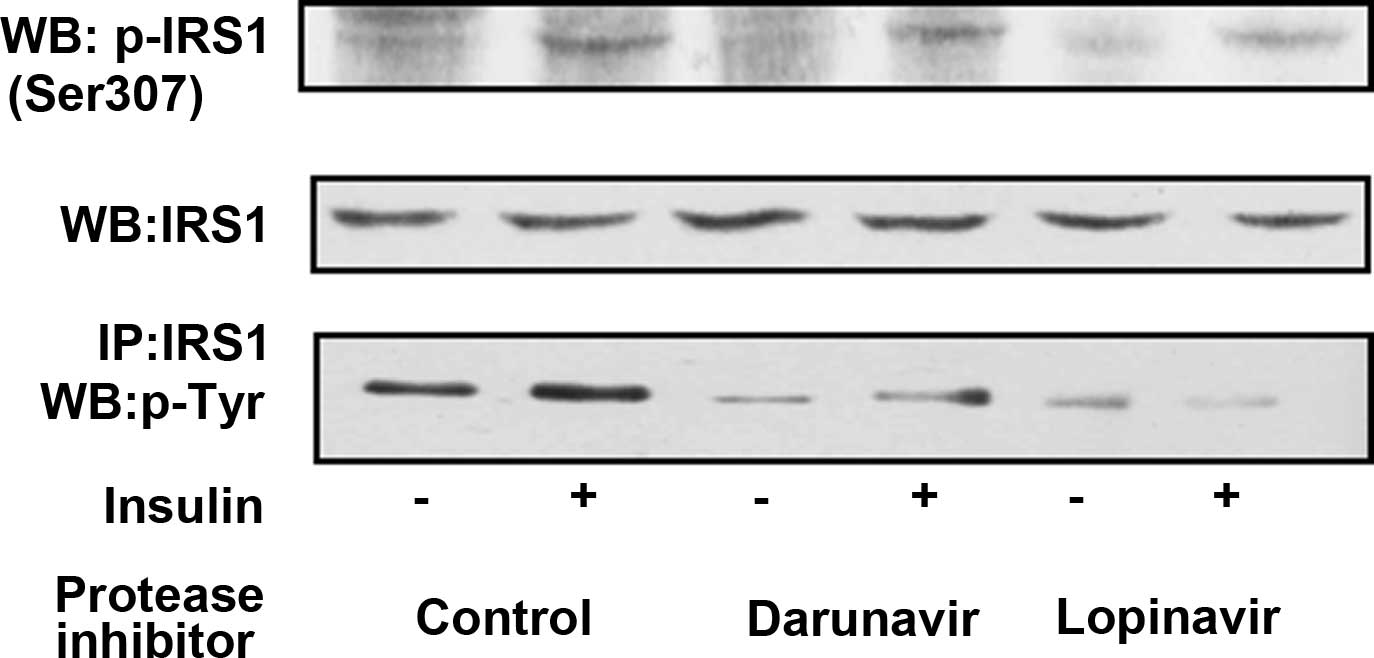|
1
|
May MT, Sterne JA, Costagliola D, et al;
Antiretroviral Therapy (ART) Cohort Collaboration. HIV treatment
response and prognosis in Europe and North America in the first
decade of highly active antiretroviral therapy: a collaborative
analysis. Lancet. 368:451–458. 2006. View Article : Google Scholar : PubMed/NCBI
|
|
2
|
Honda M and Oka S: Current therapy for
human immunodeficiency virus infection and acquired
immunodeficiency syndrome. Int J Hematol. 84:18–22. 2006.
View Article : Google Scholar : PubMed/NCBI
|
|
3
|
Murata H, Hruz PW and Mueckler M: The
mechanism of insulin resistance caused by HIV protease inhibitor
therapy. J Biol Chem. 275:20251–20254. 2000. View Article : Google Scholar : PubMed/NCBI
|
|
4
|
Nolte LA, Yarasheski KE, Kawanaka K,
Fisher J, Le N and Holloszy JO: The HIV protease inhibitor
indinavir decreases insulin- and contraction-stimulated glucose
transport in skeletal muscle. Diabetes. 50:1397–1401. 2001.
View Article : Google Scholar
|
|
5
|
Djedaini M, Peraldi P, Drici MD, et al:
Lopinavir co-induces insulin resistance and ER stress in human
adipocytes. Biochem Biophys Res Commun. 386:96–100. 2009.
View Article : Google Scholar : PubMed/NCBI
|
|
6
|
Wellen KE and Hotamisligil GS:
Inflammation, stress, and diabetes. J Clin Invest. 115:1111–1119.
2005. View Article : Google Scholar : PubMed/NCBI
|
|
7
|
Weisberg SP, McCann D, Desai M, Rosenbaum
M, Leibel RL and Ferrante AW Jr: Obesity is associated with
macrophage accumulation in adipose tissue. J Clin Invest.
112:1796–1808. 2003. View Article : Google Scholar : PubMed/NCBI
|
|
8
|
Dalpke A, Heeg K, Bartz H and Baetz A:
Regulation of innate immunity by suppressor of cytokine signaling
(SOCS) proteins. Immunobiology. 213:225–235. 2008. View Article : Google Scholar : PubMed/NCBI
|
|
9
|
Ueki K, Kondo T and Kahn CR: Suppressor of
cytokine signaling 1 (SOCS-1) and SOCS-3 cause insulin resistance
through inhibition of tyrosine phosphorylation of insulin receptor
substrate proteins by discrete mechanisms. Mol Cell Biol.
24:5434–5446. 2004. View Article : Google Scholar
|
|
10
|
Asante-Appiah E and Kennedy BP: Protein
tyrosine phosphatases: the quest for negative regulators of insulin
action. Am J Physiol Endocrinol Metab. 284:E663–E670.
2003.PubMed/NCBI
|
|
11
|
Tordjman KM, Leingang KA, James DE and
Mueckler MM: Differential regulation of two distinct glucose
transporter species expressed in 3T3-L1 adipocytes: effect of
chronic insulin and tolbutamide treatment. Proc Natl Acad Sci USA.
86:7761–7765. 1989. View Article : Google Scholar
|
|
12
|
Laemmli UK: Cleavage of structural
proteins during the assembly of the head of bacteriophage T4.
Nature. 227:680–685. 1970. View
Article : Google Scholar : PubMed/NCBI
|
|
13
|
Eron JJ, Feinberg J, Kessler HA, et al:
Once-daily versus twice-daily lopinavir/ritonavir in
antiretroviral-naive HIV-positive patients: a 48-week randomized
clinical trial. J Infect Dis. 189:265–272. 2004. View Article : Google Scholar : PubMed/NCBI
|
|
14
|
Curran A, Gutirerrez M, Deig E, et al:
Efficacy, safety and pharmacokinetics of 900/100 mg of
darunavir/ritonavir once daily in treatment-experienced patients. J
Antimicrob Chemother. 65:2195–2203. 2010. View Article : Google Scholar : PubMed/NCBI
|
|
15
|
Patick AK and Potts KE: Protease
inhibitors as antiviral agents. Clin Microbiol Rev. 11:614–627.
1998.PubMed/NCBI
|
|
16
|
Bogachus LD and Turcotte LP: HIV protease
inhibitors induce metabolic dysfunction in part via increased
JNK1/2 pro-inflammatory signaling in L6 cells. Antiviral Res.
92:415–423. 2011. View Article : Google Scholar : PubMed/NCBI
|
|
17
|
Sun XJ and Liu F: Phosphorylation of IRS
proteins Yin-Yang regulation of insulin signaling. Vitam Horm.
80:351–387. 2009.PubMed/NCBI
|
|
18
|
Ismail WI, King JA, Anwar K and Pillay TS:
Indinavir and nelfinavir inhibit proximal insulin receptor
signaling and salicylate abrogates inhibition: potential role of
the NFkappa B pathway. J Cell Biochem. 114:1729–1737. 2013.
View Article : Google Scholar : PubMed/NCBI
|
|
19
|
Goldstein BJ, Bittner-Kowalczyk A, White
MF and Harbeck M: Tyrosine dephosphorylation and deactivation of
insulin receptor substrate-1 by protein-tyrosine phosphatase 1B.
Possible facilitation by the formation of a ternary complex with
the Grb2 adaptor protein. J Biol Chem. 275:4283–4289. 2000.
View Article : Google Scholar
|
|
20
|
Ben-Romano R, Rudich A, Tirosh A, et al:
Nelfinavir-induced insulin resistance is associated with impaired
plasma membrane recruitment of the PI 3-kinase effectors Akt/PKB
and PKC-zeta. Diabetologia. 47:1107–1117. 2004. View Article : Google Scholar : PubMed/NCBI
|
|
21
|
Schütt M, Zhou J, Meier M and Klein HH:
Long-term effects of HIV-1 protease inhibitors on insulin secretion
and insulin signaling in INS-1 beta cells. J Endocrinol.
183:445–454. 2004.PubMed/NCBI
|
|
22
|
Noor MA, Flint OP, Maa JF and Parker RA:
Effects of atazanavir/ritonavir and lopinavir/ritonavir on glucose
uptake and insulin sensitivity: demonstrable differences in vitro
and clinically. AIDS. 20:1813–1821. 2006. View Article : Google Scholar : PubMed/NCBI
|
|
23
|
Tomaka F, Lefebvre E, Sekar V, et al:
Effects of ritonavir-boosted darunavir vs. ritonavir-boosted
atazanavir on lipid and glucose parameters in HIV-negative, healthy
volunteers. HIV Med. 10:318–327. 2009. View Article : Google Scholar : PubMed/NCBI
|
|
24
|
Björnholm M, Kawano Y, Lehtihet M and
Zierath JR: Insulin receptor substrate-1 phosphorylation and
phosphatidylinositol 3-kinase activity in skeletal muscle from
NIDDM subjects after in vivo insulin stimulation. Diabetes.
46:524–527. 1997.PubMed/NCBI
|













